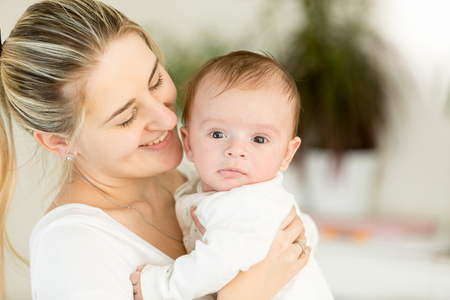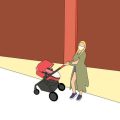Understanding the Needs of Breastfed Babies
When choosing a bottle for a breastfed baby, its essential to recognize that not all bottles are created equal. Breastfed babies have unique feeding patterns and needs, which means parents should approach bottle selection differently than they might for formula-fed infants. One of the main concerns is maintaining consistency with the way a baby latches onto the breast, as this impacts their ability to switch between breastfeeding and bottle-feeding without confusion or frustration. Bottles designed for breastfed babies typically focus on features that mimic the natural breast shape and flow, helping to support proper latch and reduce nipple confusion. Additionally, breastfed babies often feed in a slower, more controlled manner compared to those who are primarily bottle-fed. Choosing a bottle that encourages paced feeding and prevents overfeeding is crucial in supporting both your babys health and the breastfeeding journey.
2. Key Features to Look for in Bottles
When searching for the best bottles for breastfed babies, it’s crucial to focus on features that closely mimic breastfeeding and support a smooth transition between breast and bottle. Here are the essential aspects to consider:
Nipple Shape and Feel
The nipple shape should resemble a mother’s breast as much as possible to encourage a natural latch and reduce nipple confusion. Opt for wide, rounded nipples with a soft, flexible texture that moves with your baby’s mouth. This helps your baby use similar sucking motions as they would while breastfeeding.
Flow Rate
Flow rate is another key factor. Newborns and breastfed babies typically need slow-flow nipples to prevent overfeeding and allow them to control the pace of feeding—just like at the breast. Many brands offer different flow rates labeled as slow, medium, or fast, so choose one that matches your baby’s age and feeding style.
Anti-Colic Design
Colic and gas can be big concerns for parents. Bottles with anti-colic vents or systems help reduce the amount of air your baby swallows during feeds, which can minimize fussiness and discomfort. These designs often include vented bases or specialized inserts.
Material Matters
Bottles come in various materials, including BPA-free plastic, glass, silicone, and stainless steel. Each has its pros and cons regarding durability, safety, weight, and ease of cleaning. Make sure to choose a material that suits your lifestyle and priorities.
Comparison Table: Essential Bottle Features for Breastfed Babies
| Feature | Why It Matters |
|---|---|
| Nipple Shape | Mimics breast to promote proper latch & avoid confusion |
| Flow Rate | Ensures baby controls feeding pace; prevents choking/overfeeding |
| Anti-Colic System | Reduces air intake; minimizes gas & fussiness |
| Bottle Material | Affects safety, durability, weight, & cleaning ease |
Choosing the Right Combination
The ideal bottle will combine all these features to provide a feeding experience that’s as close to breastfeeding as possible. Taking time to find bottles with the right shape, flow rate, anti-colic design, and safe materials can make a real difference in your baby’s comfort—and your peace of mind.
![]()
3. Top Bottle Recommendations for Breastfed Babies
When it comes to choosing the best bottles for breastfed babies, American parents have a handful of tried-and-true favorites. Each brand and model brings something unique to the table, addressing common concerns such as nipple confusion, colic, and ease of cleaning. Here’s a closer look at some of the leading options:
Dr. Brown’s Natural Flow Bottles
Pros: Renowned for their anti-colic vent system, Dr. Brown’s bottles are a top pick for infants struggling with gas and fussiness. The slow-flow nipples also closely mimic breastfeeding, making them ideal for transitioning between breast and bottle.
Cons: The multi-piece design can be a bit cumbersome to clean and assemble, which may be challenging during late-night feedings.
Comotomo Baby Bottles
Pros: Comotomo bottles feature an ultra-soft, silicone body and naturally shaped nipple that encourages a proper latch—perfect for breastfed babies. They’re also easy to squeeze, which can help babies control milk flow as they would at the breast.
Cons: These bottles tend to be pricier than other options and may not fit into all standard bottle warmers or holders due to their wider shape.
Lansinoh mOmma Bottles with NaturalWave Nipple
Pros: Designed specifically for breastfed babies, Lansinoh’s NaturalWave nipple promotes natural sucking motions and helps maintain established breastfeeding patterns. Many moms appreciate how easy these bottles are to clean and assemble.
Cons: Some parents find that the nipples collapse if babies suck too hard, potentially causing frustration during feeding times.
Tomme Tippee Closer to Nature Bottles
Pros: With a wide, breast-like nipple and compact shape, Tommee Tippee bottles are comfortable for both parents and babies to hold. Their affordable price point makes them a popular choice among American families.
Cons: Some parents report frequent leaks if the lid isn’t screwed on just right, and the flow rate may be too fast for younger infants despite being labeled as “slow flow.”
Honorable Mentions
Bottles like Philips Avent Natural and MAM Anti-Colic also receive high marks from American parents for their thoughtful designs and compatibility with breastfeeding. Ultimately, finding the right bottle often involves a bit of trial and error—but starting with these trusted brands gives your baby (and you) the best shot at a smooth feeding journey.
4. Tips for a Smooth Bottle-to-Breast Transition
Switching between breast and bottle can be challenging for both babies and parents, especially when you want to avoid nipple confusion and feeding issues. The key is choosing the right bottle and following practical steps to make the transition as seamless as possible. Here are some tried-and-true tips that work well for American families:
Start Slow and Be Patient
Introduce the bottle gradually, ideally once breastfeeding is well established—usually after 3-4 weeks. Let another caregiver try feeding your baby with the bottle so your little one doesn’t get confused by mom’s scent or presence.
Mimic Breastfeeding Techniques
Hold your baby in a similar position as during breastfeeding, and offer paced bottle feeding to closely replicate the flow and rhythm of nursing at the breast. This helps prevent overfeeding and keeps the experience familiar for your baby.
Choose Bottles Designed for Breastfed Babies
Bottles with wide, breast-shaped nipples made from soft silicone are best for breastfed babies. These features support a natural latch and reduce the risk of nipple confusion. Check out this quick comparison:
| Bottle Feature | Why It Matters |
|---|---|
| Wide, Soft Nipple | Mimics mom’s breast, promotes natural latch |
| Slow Flow Nipple | Prevents baby from preferring fast-flow bottles over breastfeeding |
| Anti-Colic Design | Reduces air intake, making feeds more comfortable |
| BPA-Free Materials | Keeps feeding safe and healthy |
Timing Is Everything
Avoid introducing the bottle when your baby is very hungry or upset. Try offering it when your child is calm but interested in eating, such as mid-morning or early afternoon.
Stay Consistent but Flexible
If your baby resists the bottle at first, don’t stress! Keep trying daily, using different temperatures of milk or even different caregivers if needed. Some babies may prefer one type of nipple or bottle over another—it’s okay to experiment until you find what works.
5. Safe Cleaning and Storage Practices
Keeping your baby’s bottles spotless is just as important as choosing the right bottle for a breastfed baby. To protect your little one from germs and bacteria, it’s crucial to follow safe cleaning, sterilizing, and storage practices every single time.
Cleaning Bottles: The First Step to Safety
After each feeding, wash bottles, nipples, rings, and caps thoroughly using hot, soapy water. Use a dedicated bottle brush to reach all the crevices where milk residue can hide. If you prefer, most bottles are top-rack dishwasher safe—just double-check the manufacturer’s instructions. Dishwashing can be a convenient option, but always separate all parts so they get cleaned effectively.
Sterilizing: When and How Often?
The American Academy of Pediatrics recommends sterilizing bottles before first use and regularly during the early months when your baby’s immune system is still developing. You can sterilize by boiling the parts in water for five minutes or using an electric steam sterilizer or microwave sterilizer bags. Some parents continue sterilizing daily; others do it weekly once their baby is older and healthy. Choose what feels best for your family’s routine.
Proper Storage: Keeping Bottles Ready and Safe
After cleaning and sterilizing, let all bottle parts air-dry completely on a clean rack—avoid using towels that may harbor bacteria. Store dry bottles fully assembled in a closed cabinet or container to keep them dust-free until you’re ready for the next feeding. If you pre-fill bottles with expressed breast milk, label them with the date and store them in the refrigerator for up to four days or in the freezer for longer-term storage (up to six months is ideal).
By following these cleaning and storage tips, you’ll help ensure that every feeding is as safe and healthy as possible for your breastfed baby. Consistent care not only protects your child but also gives you peace of mind as you navigate the bottle-feeding journey.
6. Frequently Asked Questions from Parents
Introducing bottles to breastfed babies can be an emotional and practical challenge for many American parents. Here, we address some of the most common questions and concerns to help make the transition smoother for both you and your baby.
When is the best time to introduce a bottle to my breastfed baby?
Pediatricians in the U.S. often recommend waiting until breastfeeding is well-established, usually around 3-4 weeks old, before introducing a bottle. This helps prevent nipple confusion and ensures your baby is comfortable with breastfeeding first.
Will my baby experience nipple confusion?
Nipple confusion is a concern for many parents. Choosing a bottle with a slow-flow, breast-like nipple can help minimize this risk. Most babies adjust with patience and practice, especially if bottles are introduced gradually.
How do I choose the right bottle for my baby?
Look for bottles specifically designed for breastfed babies. Features like a wide base, soft silicone nipples, and anti-colic vents are popular among American parents because they closely mimic the breastfeeding experience and reduce gas or fussiness.
Can switching between breast and bottle affect my milk supply?
If you’re supplementing with formula or pumping less frequently, your milk supply may decrease. To maintain supply, try to pump whenever your baby takes a bottle, especially during regular feeding times.
What if my baby refuses the bottle?
This is a common scenario. Try having someone else offer the bottle when you’re out of sight, as your baby may prefer nursing when youre nearby. Experiment with different bottle types and temperatures until you find what works best.
Is it okay to use bottles if I plan to return to work?
Absolutely! Many American parents successfully balance work and breastfeeding by introducing bottles early on. Practice with your baby before returning to work so they are comfortable being fed by caregivers using a bottle.
Final Tips for Parents
Remember that every baby is unique. Be patient, stay consistent, and reach out to lactation consultants or parenting groups if you need support during this important transition.


